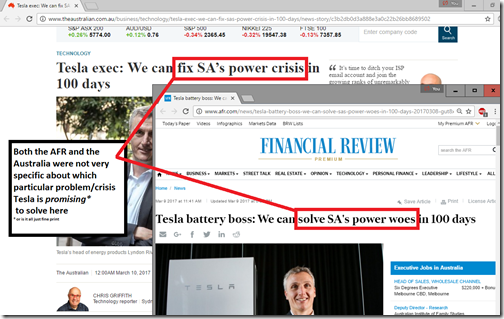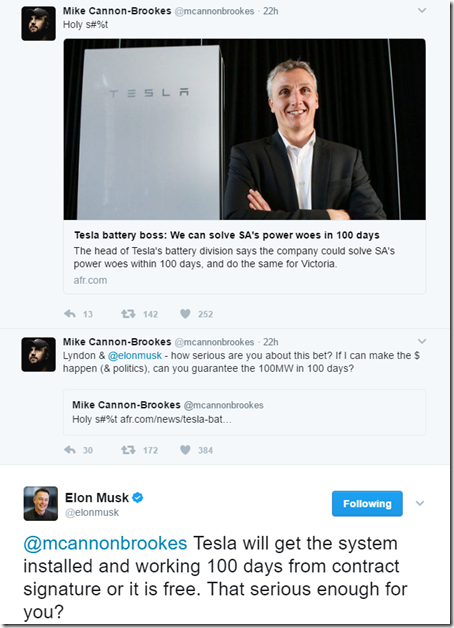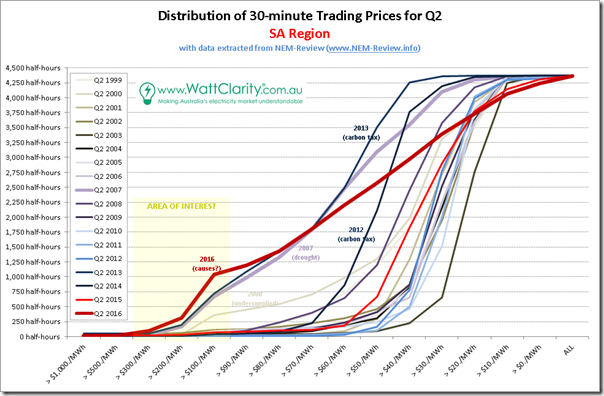Elon Musk, in a social-media triggered marketing coup that would make Richard Branson proud, certainly caused a stir last week with his announcement about saving South Australia from all it’s power woes last week. I posted a quick note about it over here on our battery-focused project site last week – and have continued to think through the implications of what it might actually mean.
(A) Which problem (of many) are we focused on solving?
Late last week, the headlines like these in the two main newspapers of substance in the country (Ben Potter in the AFR on the 9th and Chris Griffith in the Australian on the 10th) indicate that the journalists at least inferred Tesla was promising to solve South Australia’s problems, and (given the 2 very similar headings) would seem to indicate that Tesla had actually promised this:
Over the week that’s followed the initial billionaire banter on twitter, I have seen many dive in to comment about the viability (or not) of batteries for solving “the problem” – however for me I am still uncertain as to what it is that Tesla is promising* to solve.
* Accepting the near impossibility of any form of pay-for-performance in an electricity sector/market that’s as interconnected as our national grid/market, any such “promised resolution” by a Tech Company (remembering that we’re one, too) ultimately means, in the fine print, an offer to deliver a certain piece of kit – that may, on a rainy/sunny/other day, help with the aforementioned problem.
I thought it might be useful to identify that there are a number of problems that have beset South Australia over the past year or so – and that these were already annotated on the trended price chart from my post earlier in the week.
In table form, I’ve listed some of them:
| Problem #1 Two-speed prices |
In July 2016 I posted this analysis of some remarkable pricing patterns we’d observed occurring through Q2.
Readers should note that this pattern has emerged pretty much NEM-wide, and is occurring for a number of different (coincident) reasons, including the changing nature of the generation mix. Note that this is a systemic change across the NEM that poses massive challenges to established norms in so many different ways. Below I include some quick thoughts about how 100MW of storage would “solve” this particular challenge/problem/opportunity. |
| Problem #2 Increased incidence of high-high prices |
As noted in the chart posted here this week, there have been periods of extreme volatility experienced in South Australia – most notably Q3 2016.
Both this, and the two-speed pricing pattern, has driven the forward price curve through the roof – threatening business viability of many large energy users. |
| Problem #3 Blackout of 28th September 2016 |
There was the SA state-wide blackout on 28th September 2016. It’s not clear whether this was the “problem” that Tesla is pitching its batteries as the solution for.
As anyone who’s followed the energy debate in the past 6 months will know, there were a combination of reasons why this blackout occurred – and it seems there is still more investigation to be done, there. AEMO’s 3rd interim report here highlights a number of contributing factors – but a final report has not yet been produced. Nor has there been any major independent review performed (I’m thinking here of the NOUS Report produced after a similarly large blackout affecting 1,000MWs of load in Victoria after bushfires of January 2007). Perhaps this is part of the remit of the Finkel review – however I understand that Finkel believes his mandate not sufficiently broad to tally up the total cost of the blackout, for instance. |
| Problem #4 SA islanding and load shedding on 1st December 2016 |
I posted this quick analysis of the transmission disruption (and load shedding I was unaware of at the time) on 1st December 2016. |
| Problem #5 Tight supply demand and load shedding on 8th February 2017. |
I posted this quick article late on the day of the load shedding.
Allan posted this next-day analysis, and followed up with more about Pelican Point. In this particular case, AEMO did instruct 100MW of local load shedding to maintain system security: Here’s AEMO’s System Event Report for the machinations of 8th February 2017. |
| Problem #6 Near miss occurrence on 3rd March 2017. |
Our guest author, Allan O’Neil, posted this analysis of what went on during that Friday, and how lucky SA was that the lights did not go out there.
I have not seen any report on this instance yet from AEMO, thought they did issue this Media Statement on the day. ————— [UPDATE] two of our savvy readers have pointed out this AEMO report was posted on 10th March. |
The main take-away here is that there are these 6 discrete problems that I can easily identify as relevant to South Australia – all of which have occurred over the past 12 months. There are more we could list if time permitted – but I’m sure you get the point.
I’m sure that Tesla did not mean to imply that all of these would be fixed by its 100MW battery offer, but an uninformed reader (who would also equate to a voter in SA’s next elections – but also, potentially, a private Tesla customer as well) may well be led to believe that Tesla is promising to solve all of the above woes.
(B) Was the offer 100MW or was it 100MWh?
If we leave aside, for the moment, the “problem solving” question, I was also initially pretty uncertain about what is actually being promised to deliver, technically – and I’d put that down to the common confusion amongst the broader stakeholder group about the difference between a Watt (W), and a Watt-hour (Wh).
My sense, having dealt with this over many years (including with well more than half the software engineers who have ever come to work with us) is that the choice of unit unfortunately delivers a share of the confusion:
(i) People generally understand that km/h and L/s are both rates over time, and also would understand that J/s is a rate – however we chose to confuse things by choosing the Watt as the unit for rate in the power sector.
(ii) People also generally understand that a Meter, a Gram and a Litre are all measurements of some form of quantity – in the same way that they would more easily understand that a Joule is a measure of quantity – but, because we have included a unit of time in the “MWh”, people get all confused and hence sometimes label this “MW/h”
The exchange between Elon Musk and Mike Cannon-Brooks (copied again below) was framed around 100MW, but there was also plenty of chatter about 100MWh – and (as noted above) each are very different concepts:
A 1MW battery will not be the same physical item as a 1MWh battery.
My understanding of the Tesla technology is that, no matter what the size, the same underlying components are used – and essentially just stacked together to make something bigger. Hence I have referenced the specification sheets for both the old Tesla Powerwall 1 and new Tesla Powerwall 2 from our Battery Finder™ widget as shown below:
| Here’s the details page from our Battery Finder™ for the Tesla Powerwall 1 | Here’s the details page from our Battery Finder ™ for the (AC) Tesla Powerwall 2 |
 |
 |
The key metrics are summed up here:
| Tesla Powerwall 1 | Tesla Powerwall 2 (AC) | |
| Nominal Capacity | 6.4 kWh (a quantity) |
13.2kWh (a quantity) |
| Nominal Output Power | 3.3 kW (a rate of discharge) |
5 kW (a rate of discharge) |
| … therefore, to produce this 100MW battery bank, would need … | 30,304 units | 20,000 units |
| … which would deliver… | 194MWh of storage from 100% to 0% discharge (a quantity) |
264MWh of storage from 100% to 0% discharge (a quantity) |
As can be seen, either option (old model, or new) would have had sufficient capacity to discharge the 45MWh required by AEMO in Problem #5 – assuming they had a reasonable level of charge prior to the event.
… however let’s delve into more detail below…
(C) With this hypothetical 100MW of battery storage, how would it address each problem?
I had intended to walk through each of the 6 discrete problems above, to identify how 100MW of battery storage would have addressed each of these – however I’m running out of available hours today, so am only able to add quick thoughts:
(C1) Addressing Problem #1 (two-speed prices) with 100MW of battery storage
The two speed pricing problem arises because of a number of factors – but a key factor in the mix is the intermittency of wind (in the South Australian case). This “yin and yang of wind” animation, using NEM-watch, helps to illustrate this for those who are unaware.
What the oft-quoted “Merit Order Effect” gives on the one hand (in terms of suppressing prices when the wind blows) it takes away on the other (in terms of contributing to closure decisions on volume-starved thermal capacity, which might otherwise have helped to keep prices down in the non-windy periods). The jump in gas prices and closure of Northern has made the gap between the “high” step and the “low” step much greater.
Unfortunately, the volume of energy, and number of hours involved, suggest that 100MW of storage would be just a drop in the bucket compared to the quantum of storage that would be needed to effectively address this growing (and significant) challenge.
This challenge is what this particular back-of-the-envelope exercise was focused on in 2015 – and I followed up with more detailed analysis here for a hypothetical “10x scenario” later in 2015.
From last year’s analysis of Q2 2016 I have lifted the following chart:
A key number, here is that in Q2 2016 there were at last 1,000 half-hours where the trading price was above $100/MWh. Because of the nature of the generation mix at these times (typically there is 1,000MW of wind missing from the actual mix – hence much reduced competition) I have significant doubts that 100MW of storage would make much difference to price outcomes.
Effectively it would require to be 10x as large (back-of-the-envelope) to “replace” the missing wind and, because of the pattern of wind variability and battery round-trip efficiency, would require at least as much wind generation again to be installed as a charging source when windy.
Not a fast solution, and not one the SA government could easily fund I suspect.
(C2) Addressing Problem #2 (more high-high prices) with 100MW of battery storage
In terms of the higher prices, we see in the chart above (for Q2 2016) a much lower incidence of prices above $300/MWh – and, though the incidence will have been higher for Q3 2016, will still have been an order of magnitude or more lower.
Far more likely, I think, that 100MW of storage might have some effect here in knocking off some (but not all) of the extreme peaks in price.
(C3) Addressing Problem #3 (the blackout of 28th September) with 100MW of battery storage
Would 100MW of battery storage have helped here when multiple cascading failures led to a state-wide blackout? Without going into detail on the sequence of events it seems unlikely that 100MW of battery storage (or “just” 100MW of anything) would have made much difference, in the end.
(C4) Addressing Problem #4 (islanding on 1st December) with 100MW of battery storage
No time to think through this at all.
(C5) Addressing Problem #5 (load shedding on 8th February) with 100MW of battery storage
As noted above, it does appear that this was the specific “problem” identified by Tesla that this particular solution would solve – as 100MW of load shedding was called for. In this case, it seems that 100MW of storage would deliver the solution required.
It’s a separate issue that 300-400MW of load shedding was delivered (as we noted in our article on the day) – but I’m not sure an analyst would credit these hypothetical batteries for “saving” this additional accidental load shedding in a hypothetical future case.
(C6) Addressing Problem #6 (near miss on 3rd March) with 100MW of battery storage
No time to analyse this in any detail at all.
Two conclusions, here, are that 100MW of batteries would probably have helped with Problem #5 – but that the imprecise and nebulous wording of the “promise to cure SA of its woes” (whether deliberate marketing, or innocent mistake) seems likely to add to fuel to the fire of customer scepticism about the energy sector in more general terms (i.e. seen/inferred to make promises it can’t deliver on), and hence continue the reduction in our collective social licence to operate.
Not a position any of us really want to be in, I would think?
(D) We’ll be at Queensland Energy Storage Summit on Wednesday next week, 22nd March (and want to speak with you)
Finally, I’d just like to note that we’ll be speaking at the Queensland Energy Storage Summit on Wednesday next week in Brisbane – about the Energy Storage Register project we’re collaborating on, and how this is spinning off other items of value to the industry – like the Battery Finder™ widget utilised above.
We’re looking to add to our team keen volunteers/collaborators to continue to push this project forward so would ask that you catch us at this event if you are keen, and fit into either of the following two categories:
1) You’re involved in the storage sector in some way such that you could contribute data to the Energy Storage Register; and
2) You don’t have data yourself, but would find value in being able to access and utilise the data we’re collecting in the register, understanding that it is subject to Privacy Restrictions.
If you miss us there, could I suggest that you do any or all of the above:
Action 1 = check out the growing volume of information we are publishing on the specially-focused site www.BatteryStorage.info
Action 2 = give us a call on (+61 7 3368 4064), or email us at storagedatabase@global-roam.com
Action 3 = catch us at another event late in the year in your own location (for instance, we’ll probably also be at this solar and storage conference on 3rd and 4th May in Melbourne).





Love your analysis as always Paul. One comment about your conclusion in C1. The following is a simplistic analysis assuming that all electricity is traded on spot market, but hopefully it has enough truth that it demonstrates my point. If you look at periods in the last 12 months where demand in SA exceeded 2.6 GW (43 half hour periods), price increases very steeply with demand. It’s not a great correlation, but a linear fit indicates a $23/MWh increase in spot price for every MW increase in demand. A 100 MW battery could potentially reduce prices at this extreme end of the spectrum by over $2000 per MWh. That’s a saving of over $6m per hour, or $137 million over the 43 half hour periods. That represents 10% of the total value of the SA spot market in the last year, and goes a long way towards justifying the cost of the battery.
My understanding is that the 100MW gas turbine at Quarantine failed to start under load, and that is seen by AEMO as the straw that broke the camels back
The protection system for other power plants and the interconnector often uses an I^2t rule which depends on the thermal time constant of the systems. It might be set at a number like 100 so if the over-current is say 10% the system will stay on line for 100/(1.1)^2 = 80 seconds. If the load went to 160% of rated load it would shut down after 40 seconds.
100MW of batteries could have allowed three things,
a) a lower peak load on the interconnector therefore a longer time before trip
b)some controlled load shedding
c) some useful governor response on the gas plants that were running
b) Ramp time for Quarantine and reciprocating plants so that would then have been stable enough to take up the load.
I don’t know the exact numbers but 100-150MW of batteries (including grid controlled behind the meter systems) may have just halted the slide
May I suggest an addition to the problem list?
Problem #7
Black Start
Solution: A big battery and an OCGT.
===================
If we think back to the September blackout, there was an issue with the black restart arrangements; they failed to work and SA’s grid had to be restarted with a long ‘jump lead’ from Victoria. In the absence of the interconnectors, SA needs a new battery to cold start its first OCGT to re-energise its grid. That allows wind and solar to reconnect. It makes sense to me.
It makes for an interesting operational issue. Do you run down the battery to try to prevent an interconnector trip or do you save the charge for the black restart? If you are leaving the NEM, you definitely need a big starter battery with a full charge at all times.
The battery’s primary job is to cold start the OCGT but it may also be good for supplying inertia/voltage support into the system during grid transients for very short periods of time. I would not expect the battery to be regularly deep cycled, so a long life is in prospect. The OCGT is available to run when prices are high enough for it to make a profit; that might be the end of $14,000MWh prices spikes. Run at minimum load, the OCGT would provide some system inertia, reactive power and spinning reserve, although spinning reserve is useless in SA until after the instant when the Heywood interconnector opens.
If I was rebuilding a grid system for full independence, this is where I would start.